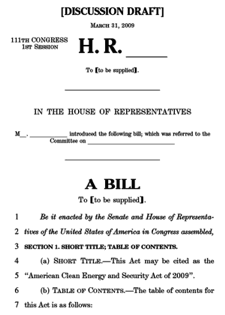I think the American Clean Energy and Security Act of 2009 is a potentially landmark first step to usher America into a powerful clean energy economy that will create millions of jobs for American workers, save consumers and businesses hundreds of billions of dollars in energy costs, make our country energy independent, and limit global warming pollution. While very comprehensive, the bill, as presently written, still have areas that need further improvements to meet science-based goals to combat the threat of global warming in the immediate future. We must also ensure that workers in older industries that are highly reliant on carbon based energy – and the communities in which they’re concentrated – are provided with the assistance and tools necessary to make the transition to the clean energy economy. I ask Congress to continue to work to strengthen these provisions before it is voted on.
Blog Post
The American Clean Energy and Security Act of 2009

- Subtitle A - Building Energy Efficiency Programs
- Sec. 201. Greater energy efficiency in building codes.
- Sec. 202. Building retrofit program.
- Sec. 203. Energy efficient manufactured homes.
- Sec. 204. Building energy performance labeling program.
-
an excerpt: The applicable target for overall nationwide energy savings, compared to the 2006 IECC for residential buildings and ASHRAE Standard 90.1-2004 for commercial buildings, for the national model building energy codes and standards shall be 30 percent in editions of each model code or standard released after the date of enactment of the American Clean Energy and Security Act of 2009; 50 percent in editions of each model code or standard released after January 1, 2016. Any target set by the Secretary... shall be set at the maximum level of energy efficiency that is technologically feasible and life-cycle cost effective, and on a path to achieving net-zero-energy buildings. (There's a lot more language than this, and I'll be honest — I don't know what it means. If anybody wants to give it a read and report back in the comments, that would be great. As far as I can decipher, new buildings will be required to have 30% energy use reduction by 2010, and 50% in 2016, with new targets set every three years afterward.)
-
an excerpt: The Administrator shall develop and implement, in consultation with the Secretary of Energy, standards for a national energy and environmental building retrofit policy for single-family and multi-family residences. The Secretary of Energy shall develop and implement, in consultation with the Administrator, standards for a national energy and environmental building retrofit policy for commercial buildings. The programs to implement the residential and commercial policies based on the standards developed under this section shall together be known as the Retrofit for Energy and Environmental Performance (REEP) program. The purpose of the REEP program is to facilitate the retrofitting of existing buildings across the United States to achieve maximum cost-effective energy efficiency improvements and significant improvements in water use and other environmental attributes. The REEP program shall utilize Federal personnel and resources as needed for development, design, program materials, administration, seed capital, and other activities and support. (Does this sound like the Environmental Service Corps?)
- This is about mobile home upgrade replacement rebates.
-
an excerpt: The Administrator shall establish a building energy performance labeling program with broad applicability to the residential and commercial markets to enable and encourage knowledge about building energy performance by owners and occupants and to inform efforts to reduce energy consumption nationwide. The Administrator shall publish a final rule containing a measurement protocol and the corresponding requirements for applying that protocol. Such a rule shall define the minimum period for measurement of energy use by buildings of that type and other details for determining achieved performance... shall identify necessary data collection and record retention requirements...
Published April 6, 2009 Permalink Citation
(2009, April 6). The American Clean Energy and Security Act of 2009. Retrieved from https://www.buildinggreen.com/blog/american-clean-energy-and-security-act-2009
Comments
There's a summary of the bill
There's a summary of the bill at http://energycommerce.house.gov/Press_111/20090515/hr2454_summary.pdf - go to the bottom of page five for capsules of the provisions of Title II – Energy Efficiency.



Add new comment
To post a comment, you need to register for a BuildingGreen Basic membership (free) or login to your existing profile.